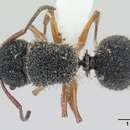en
names in breadcrumbs


Taxonomic history
Forel, 1913l PDF: 133 (q.).[Misspelled as Echinopla pallidipes by Dalla Torre, 1893 PDF: 272; Emery, 1925d PDF: 211.].See also Zettel & Laciny, 2015a PDF: 110.E. nigra, hispida; oculis protninentibus; abdomine globoso; squama in utroqne latere spina horizontali; pedibus pallide testaceis.
Worker. Length 21/2 lines. Black, rugose; the abdomen vermiculate, interpersed with slight elevations placed in great regularity over the entire upper surface, each elevation terminating in a hair; the scape and the mandibles ferruginous; the eyes very prominent; the palpi and legs pale testaceous, with the tarsi rufo-piceous; the peduncle transverse, produced on each side into a short horizontal spine; the abdomen rufo-piceous.
Hab. Borneo (Sarawak).
It is very difficult to describe the sculpturing of this insect; on the head it is strongest; the species strongly resembles E. melanarctos , but the elevations are shorter, as well as the hairs at their apex.
, Smith, Proc. Linn. Soc. ii. 80. 2.
Hab. Celebes; Borneo.
[[ worker ]]. Recoltee a Sumatra par le Dr Klaesi (collection Autran).
Von dieser Art erhielt ich durch H. Smith zwei Arbeiter; ich halte es nicht fuer ueberfluessig, zu Smith's Beschreibung im Cat. pag. 198 Einiges hinzuzufuegen : Thorax viereckig, vorne wenig breiter als hinten, seitlich ohne Einschnitte, ohne erhobenen Rand und oben ohne Spur einer Naht. Interessant sind die kleinen kegeligen Erhoehungen am Thorax, welche an ihrer abgerundeten Spitze ein langes, aufrechtes Haar tragen und ueberdiess in der Mitte ihrer Hoehe von einem sternfoermigen Kranze horizontaler, gelber Haerchen gekroent sind. Smith nennt die Sculptur des Hinterleibes: „ vermiculate ", ein sehr gelungener Ausdruck, da diese Sculptur wirklich mit einer Masse ineinander geschlungener Anneliden ziemliche Aehnlichkeit hat; die Sculptur ist naemlich sehr grob verworren gerunzelt mit vielen eingestreuten sehr groben und tiefen Puncten, ueberdiess sind auch die kleinen Kegel, welche die Borstenhaare tragen, vorhanden.
Echinopla pallipes, Smith , Proc, Linn. Soc. ii. 80. 2 [[worker]].
Worker. Length 2- 1/2 lines. - Black: body hispid; eyes prominent. Abdomen globose, node of the peduncle transverse, produced on each side into an acute spine; legs pale testaceous. Head and thorax rugose; the abdomen vermiculate, and covered with slight elevations placed in great regularity over the entire upper surface, each elevation terminating in a hair. The scape and the man- dibles ferruginous, the eyes very prominent, the palpi and legs pale testaceous, with the tarsi rufo-piceous. Abdomen obscurely rufo-piceous.
Hab. Borneo (Sarawak).
The sculpture of this insect is difficult to describe: the head and thorax are the most coarsely rugose, the rugosity being regularly interspersed with short blunt spines, each having a single hair springing from its summit.